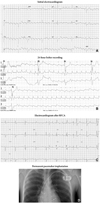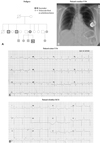Abstract
A 29-year-old man was referred to the emergency department with a complaint of abdominal pain and dizziness. He had experienced two previous syncopal episodes. His family history revealed that his mother and his two uncles had received permanent pacemaker implantation. His initial heart rate was 49 beats per minute. The electrocardiography (ECG) showed atrial flutter and right bundle branch block (RBBB) with left anterior fascicular block (LAFB). On admission, 24-hour Holter showed ventricular pause up to 16 seconds during syncope. Radio frequency catheter ablation (RFCA) of atrial flutter was performed. The ECG revealed bifascicular block (RBBB and LAFB) and first-degree atrioventricular block. He received a permanent pacemaker implantation. His brother's and his sister's ECGs also showed trifascicular block and the pedigree showed autosomal dominant inheritance. This patient was diagnosed with a progressive familial heart block (PFHB) type I. This would be the first report of a PFHB type I case documented in Korea.
Progressive familial heart block (PFHB) type I is an autosomal dominantly inherited cardiac conduction disorder that may progress to complete atrioventricular (AV) block. In 1986, Van der Merwe et al.2) described the clinical and electrocardiography (ECG) confirmation of the progressive nature of this disease. Type I PFHB is characterized by right bundle branch block (RBBB), left anterior fascicular block (LAFB), prolonged PR interval, or complete AV block with broad QRS complexes.1)2) Type I PFHB has been were widely prevalent among patients in the Republic of South Africa, and there are very few reports of this disease in Asians, it has especially never been reported in Koreans.
A 29-year-old man was referred to the emergency department with a complaint of abdominal pain and dizziness. He had experienced two episodes of syncope during exertion, one episode 7 years ago and the other 25 years ago. Family history revealed that his mother had received a permanent pacemaker implantation at 51 years of age (Fig. 2B). In addition, his two uncles had also received a permanent pacemaker implantation. On physical examination, his blood pressure was 120/80 mmHg, heart rate was 49 beats per minute, respiratory rate was 20 times per minute and temperature was 36.8℃. His ECG showed atrial flutter with variable ventricular response and bifascicular block (RBBB and LAFB) (Fig. 1A). The echocardiogram showed a mild left ventricular systolic dysfunction (ejection fraction=50%), enlarged left and right atrium. On the third day of hospitalization, the 24-hour Holter showed ventricular pause up to 16 seconds during syncope (Fig. 1B). At this time a temporary pacemaker was inserted. Radio frequency catheter ablation (RFCA) with bidirectional cavotricuspid isthmus block of atrial flutter was performed. After RFCA, the ECG revealed bifascicular block (RBBB and LAFB) and marked first-degree AV block (Fig. 1C) and the 24-hour Holter showed an intermittent second-degree AV block. He received a permanent pacemaker implantation with DDD type of pacemaker because of frequent episodes of symptomatic high-degree AV block (Fig. 1D).
His brother's and his sister's ECGs also showed trifascicular block (Fig. 2C and D) and the pedigree showed an autosomal dominant inheritance (Fig. 2A).
In 1977, Brink and Torrington1) reported the existence of a new autosomal dominant inherited familial heart disease of PFHB, which primarily affects the conduction tissue of the heart. The ECG features of type I PFHB are defined by evidence of RBBB, LAFB, prolonged PR interval or complete heart block with broad QRS complexes.2) These ECG features differentiate type I PFHB from type II PFHB, in which the onset of complete heart block is associated with narrow QRS complexes.2) Type I PFHB is manifested symptomatically when complete heart block develops, as dyspnea, syncopal episodes, or sudden death. The pathophysiology of this disease is unknown. However, linkage analysis and positioning cloning offer a means of identification of disease-causing genes. Brink et al.3) reported that the type I PFHB was genetically mapped to a group of four linked loci on chromosome 19q13.2-13.3 by means of linkage analysis. Bardien-Kruger et al.4) provided evidence for the exclusion of KCNA7, which resides on chromosome 19q13.3 in a region of the type I PFHB locus, as the type I PFHB-causative gene. Direct sequencing of KCNA7's coding sequence in type I PFHB-affected individuals revealed no pathogenic sequence changes, however two single nucleotide polymorphisms detected in exon 2 resulted in amino acid substitutions. Recently, type I PFHB was mapped to chromosome 19q13, and a novel causal gene, TRPM4, a member of the transient receptor potential melastatin family of ion channel genes, was recently identified by positional cloning.5) Treatment of type I PFHB is by the timely implantation of a permanent pacemaker. Treatment with a prophylactic pacemaker is controversial.6) Follow-up at at least 6-months with ECG is recommended in the patients with any degree of heart block and at least an yearly examination is recommended in members of the affected families with a normal ECG.7) Even though the global incidence of type I PFHB is unclear, this disease may not be confined to South Africa only. There are a very few reports on familial tendency of bradyarrhythmia in Koreans.8) This would be the first report of type I PFHB case documented in Koreans.
Figures and Tables
Fig. 1
Initial ECG shows atrial flutter with bifascicular block; RBBB and LAFB (A). Twenty four-hour Holter shows asystole up to 16 seconds (B). ECG after RFCA shows trifascicular block; first-degree atrioventricular block, RBBB and LAFB (C). The patient received a permanent pacemaker implantation (D). ECG: electrocardiography, RBBB: right bundle branch block, LAFB: left anterior fascicular block.

References
1. Brink AJ, Torrington M. Progressive familial heart block: two types. S Afr Med J. 1977. 52:53–59.
2. van der Merwe PL, Weymar HW, Torrinton M, Brink AJ. Progressive familial heart block: part II. clinical and ECG confirmation of progression-report on 4 cases. S Afr Med J. 1986. 70:356–357.
3. Brink PA, Ferreira A, Moolman JC, Weymar HW, van der Merwe PL, Corfield VA. Gene for progressive familial heart block type I maps to chromosome 19q13. Circulation. 1995. 91:1633–1640.
4. Bardien-Kruger S, Wulff H, Arieff Z, Brink P, Chandy KG, Corfield V. Characterization of the human voltage-gated potassium channel gene, KCNA7, a candidate gene for inherited cardiac disorders, and its exclusion as cause of progressive familial heart block I (type I PFHB). Eur J Hum Genet. 2002. 10:36–43.
5. Brink PA, Moolman-Smook JC, Corfield VA. Mendelian-inherited heart disease: a gateway to understanding mechanisms in heart disease Update on work done at the University of Stellenbosch. Cardiovasc J Afr. 2009. 20:57–63.
6. Brink PA, Moolman JC, Ferreira A, et al. Genetic linkage studies of progressive familial heart block, a cardiac conduction disorder. S Afr J Sci. 1994. 90:236–240.
7. van der Merwe PL, Weymar HW, Torrington M, et al. Progressive familial heart block (type I): a follow-up study after 10 years. S Afr Med J. 1988. 73:275–276.
8. Kim WJ, Shim JJ, Kim HS, et al. Familial sick sinus syndrome. Korean Circ J. 2003. 33:1155–1160.




 PDF
PDF ePub
ePub Citation
Citation Print
Print



 XML Download
XML Download